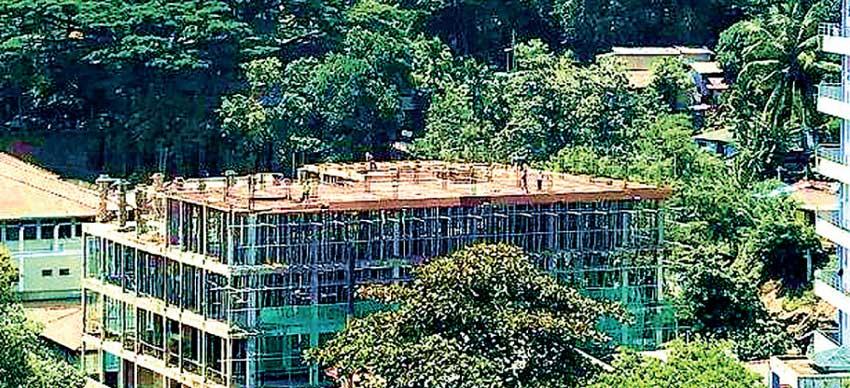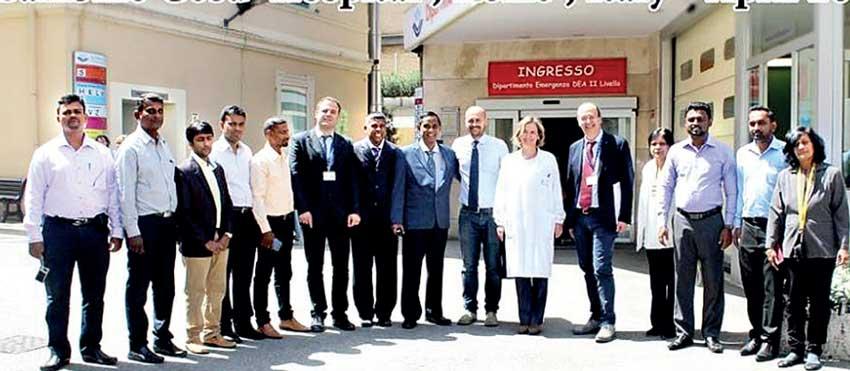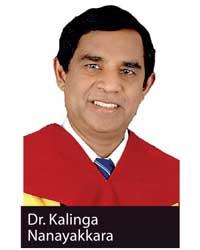22 Sep 2022 - {{hitsCtrl.values.hits}}

Upcoming Bone Marrow Transplant Centre

Study tour with Architects and Engineers to BMT Centre in the Italy 2018
 Lanka Thalassaemia Circle (LTC) in 2017, initiated a project to build a government-sponsored Bone Marrow Transplant (BMT) Centre, free of charge for Thalassaemia patients who cannot afford millions of rupees for BMT surgeries carried out in private hospitals. As a result of unrelenting efforts by LTC, the Government initially allocated Rs.856 million for a non-fee levying Bone Marrow Transplant Centre in Kandy. When completed, this BMT centre will be one of the largest BMT centres in South Asia. The construction of this Centre began in 2017 at the Teaching Hospital Kandy and is expected to be completed later this year. The Daily Mirror spoke to the Consultant Obstetrician and Gynaecologist and patron of LTC, Dr. Kalinga Nanayakkara regarding the project.
Lanka Thalassaemia Circle (LTC) in 2017, initiated a project to build a government-sponsored Bone Marrow Transplant (BMT) Centre, free of charge for Thalassaemia patients who cannot afford millions of rupees for BMT surgeries carried out in private hospitals. As a result of unrelenting efforts by LTC, the Government initially allocated Rs.856 million for a non-fee levying Bone Marrow Transplant Centre in Kandy. When completed, this BMT centre will be one of the largest BMT centres in South Asia. The construction of this Centre began in 2017 at the Teaching Hospital Kandy and is expected to be completed later this year. The Daily Mirror spoke to the Consultant Obstetrician and Gynaecologist and patron of LTC, Dr. Kalinga Nanayakkara regarding the project.
A lifesaving mission
According to Dr. Nanayakkara, there are about 2000 Thalassaemia major children and 500,000 Thalassaemia carriers in Sri Lanka. Most of these carriers are not aware of their carrier status. He says Thalassaemia is a hitherto incurable genetic disease which is genetically transmitted by both parents who are Thalassaemia carriers, with half the abnormal Thalassaemia genes but without any physical deformity themselves, except for the lifelong low haemoglobin level. The main cure available today for Thalassaemia is BMT.
Thalassaemia Major Children need blood transfusions monthly, from six months of life onwards, lifelong, along with iron chelation therapy almost daily to reduce their iron overload resulting from the monthly blood transfusions. Every year the Health Department spends Rs. 1,700 million on Thalassaemia medication alone. This is 7 % of our national drug budget. However most die at a younger age due to severe complications of iron overload affecting their vital organs, Dr. Nanayakkara says.
Dr. Nanayakkara says, “We formed LTC in 2012 to fight for the neglected rights and definitive treatment of these Thalassaemic children. LTC comprises Thalassaemia patients, their parents and well-wishes. LTC is affiliated with the Thalassaemia International Federation (TIF) in Cyprus and membership now totals around 1000+ Thalassaemia families.
Dr. Nanayakkara travelled to Rome in October 2012 and met Prof. Guido Lucarelli, the Director Mediterranean Institute of Hematology in Rome. Dr.Lucarelli is a pioneer in BMT and spoke of the possibility of setting up a bone marrow stem cell treatment Centre in Sri Lanka.
Dr. Nanayakkara says LTC on previous occasions has helped to establish BMT in two large private hospitals in Colombo, namely Asiri Central and Nawaloka Hospital, in collaboration with Dr. Lawrence Faulkner, medical director of the Cure2Children Foundation in Florence, Italy. Prof. Lalindra Guneratne was the Sri Lankan consultant who led the team to first perform BMT at the Asiri Central Hospital together with the Italian Dr. Lawrence Faulkner
Dr. Nanayakkara says that in private sector hospitals the cost of a BMT exceeds Rs. 4.2 million each, which is way beyond the means of most parents.
Following the visit of Pope Francis to Sri Lanka in 2015, the Apostolic Nuncio to Sri Lanka, Archbishop Pierre Nguyen Van Tot arranged for the possibility of obtaining the services of clinicians of the ‘Bambino Gesu’ hospital in the Vatican, to help us in Sri Lanka. At their request eight engineers and architects of the Central Engineering Consultancy Bureau, Director and Haematologist of Teaching Hospital Kandy and four members of the Lanka Thalassaemia Circle visited the large BMT Centre of the ‘Bambino Gesu’ hospital in April 2018, to familiarize themselves with the building construction and BMT procedure, Dr. Nanayakkara says.
According to Dr. Nanayakkara Rs. 856 Million was originally allocated by the Cabinet in 2017. However, as this site was situated at the Centre of the hospital the then Director, Dr. Saman Ratnayake added five more units to it extending it up to seven floors. Basement for the hospital main drug stores, ground floor for the Hospital main kitchen which was demolished, CSSD (Hospital main sterilizing unit), Endoscopy unit and two floors for the hospital main Blood Bank, upper two floors for Bone Marrow Transplant, according to the Hospital Master plan. This escalated the costs to Rs. 1,598 million and for this cabinet approval was obtained only in 2020. At present the six-floor skeletal building structure is complete. However, due to the present financial situation only Rs 5 to 10 million is released monthly by the Health Ministry. With more than 30 patient rooms this will be one of the largest BMT Centres in Asia. It will help the people who will otherwise have to spend their ‘family silver’ to cure their children.
BMT- a potential cure
Dr. Nanayakkara says, “BMT for Thalassaemia will require a near-normal genetic matching of human leukocyte antigen (HLA) between the patient and the donor. Prior to HLA molecular typing being available in Sri Lanka, in 2013 we sent the first set of 100 ‘cheek swabs’ to a Genetic Laboratory in New York in the United States at the request of the President of Singapore’s Bone Marrow Donor Programme. Sets of 100 ‘cheek swabs’ have been sent to New York regularly since then, also from Colombo, Chilaw, Batticaloa and Kurunegala etc. For re-confirmation, second samples were sent to a Genetic Laboratory in Germany. After testing more than 1000+ families we now have about 100+ Thalassaemic children completely HLA matched with their siblings and ready for the transplant.”
Dr. Nanayakkara says everyone should get themselves checked for their Thalassaemia status before marriage through the HPLC blood test, at the nearest General Hospital. He says the transplants done so far are with fully compatible Bone Marrow. Matched individuals are difficult to find. Now world over BMT is done with half-matched parental Bone Marrow, which is called Haplo-identical Transplant. We need experienced foreign doctors to train our doctors for this transplant and in future we expect more funding for this from benefactors,” Dr. Nanayakkara says.
25 Nov 2024 1 hours ago
25 Nov 2024 2 hours ago
25 Nov 2024 2 hours ago
25 Nov 2024 4 hours ago
25 Nov 2024 4 hours ago